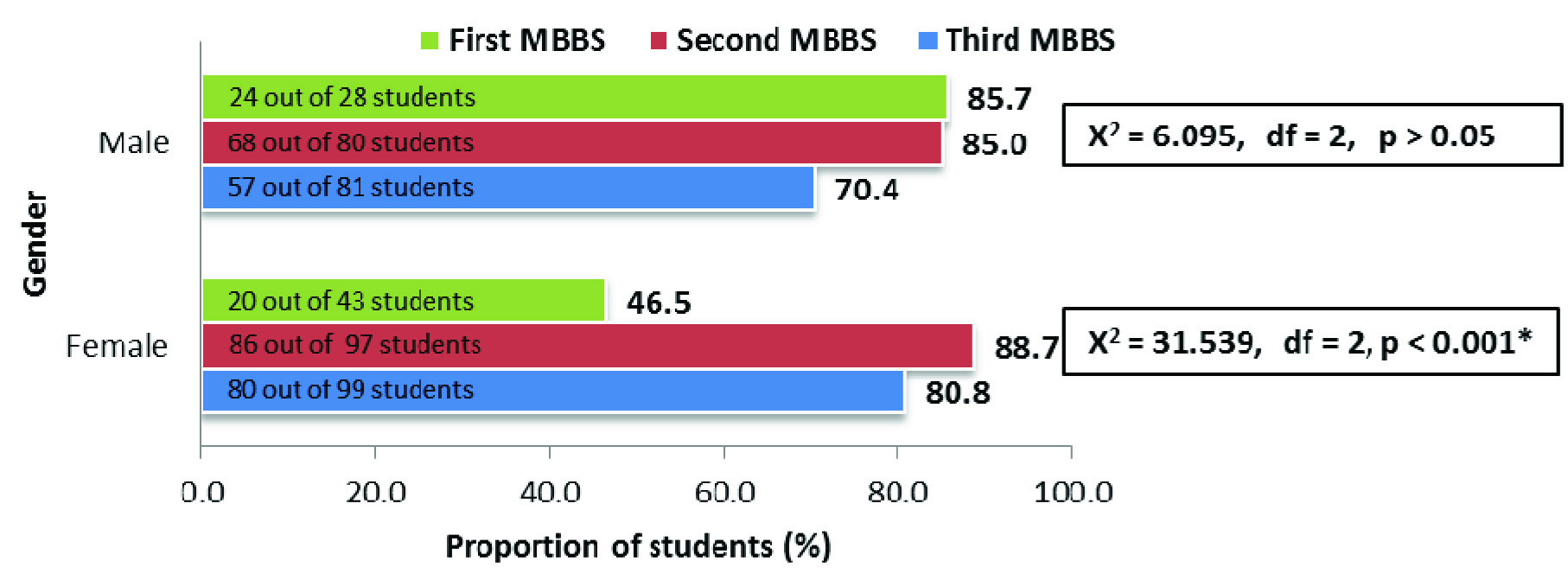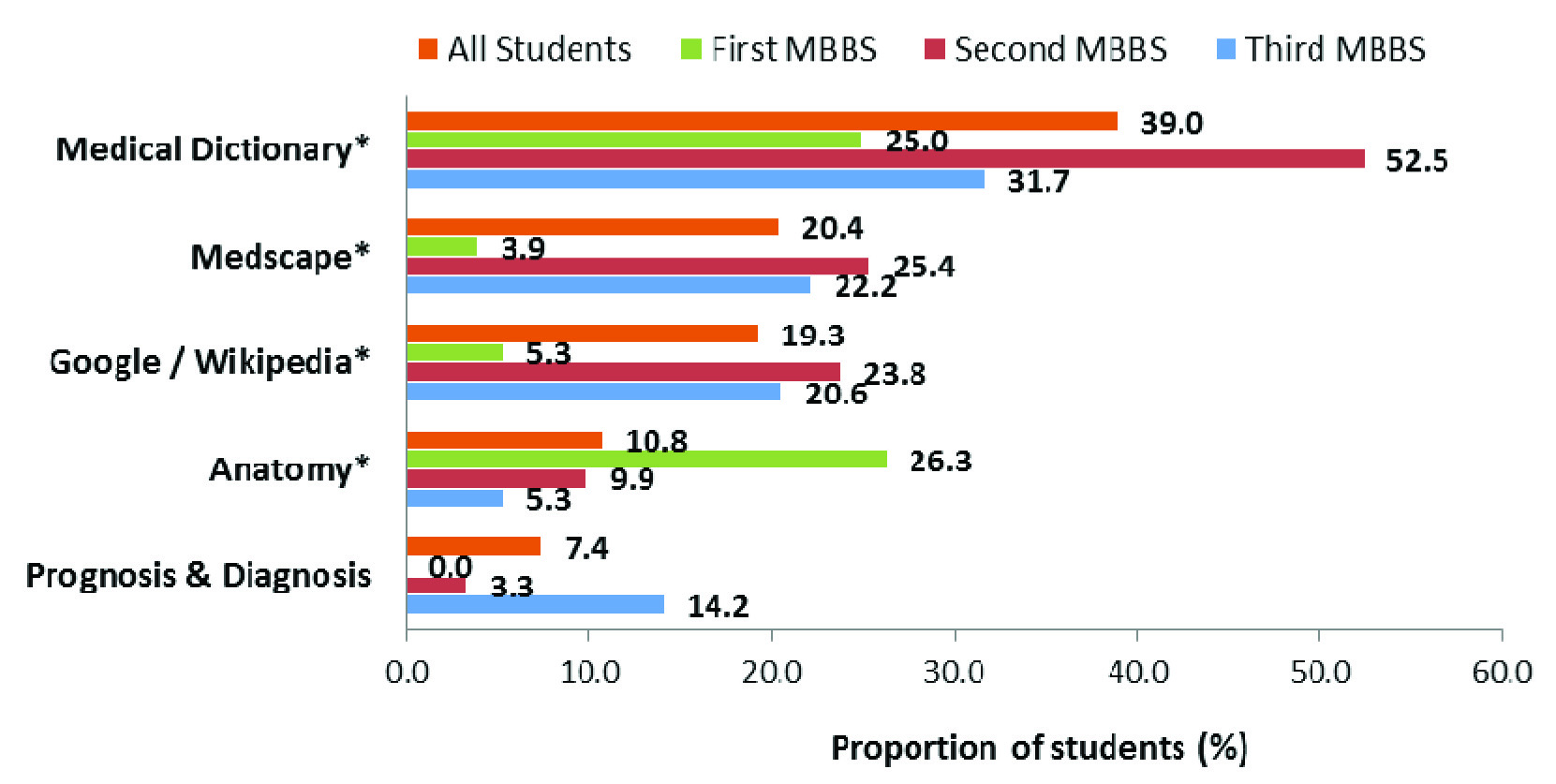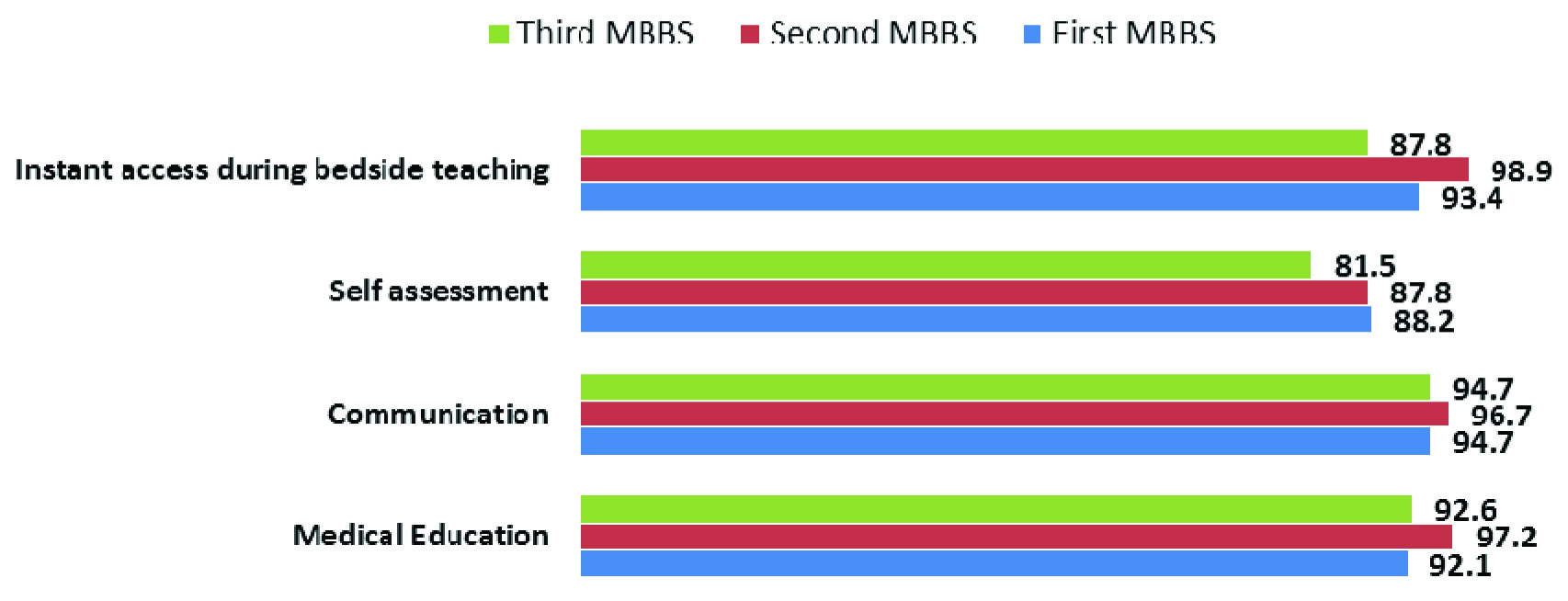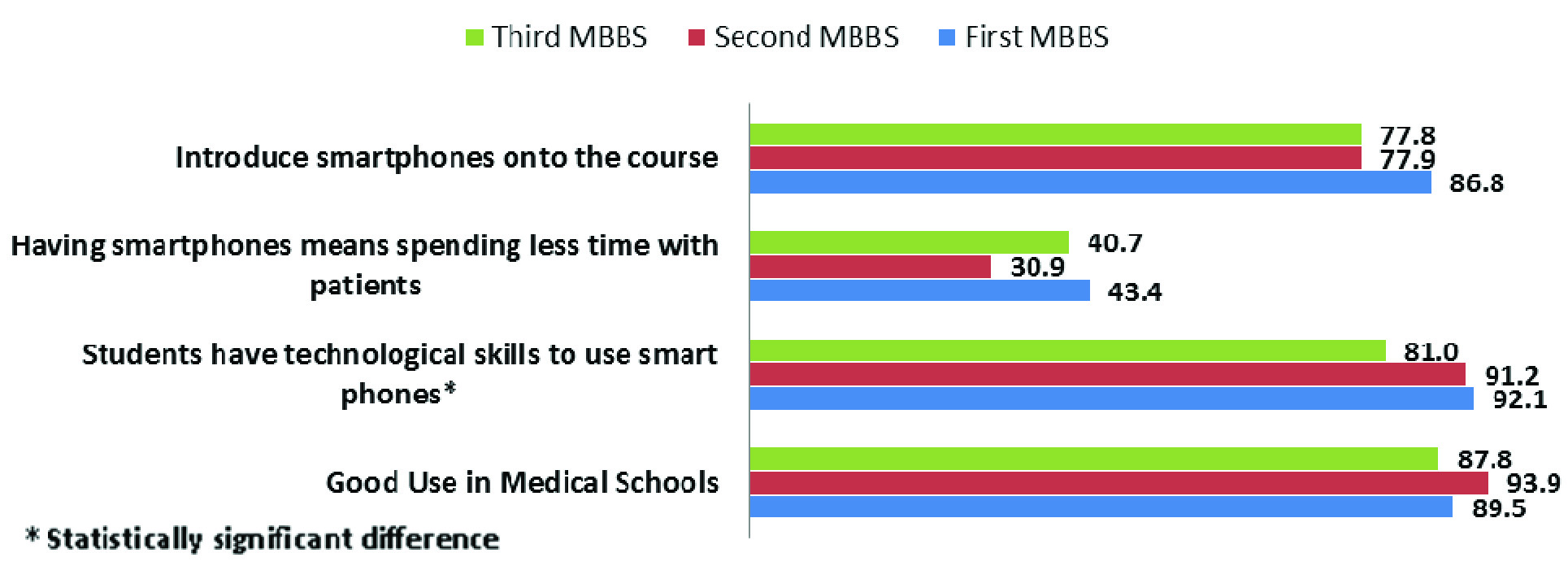Smart phones are becoming increasingly popular in both personal and professional spheres [1]. The last decade has seen the introduction of new technology which has transformed many aspects of our culture, commerce, communication and education. The smart phones have been rapidly adopted in many countries, providing easy access to information in ways that was not possible before [2].
Smart phones are thought, for several reasons, to be a particularly suitable tool for advancing education in developing regions. The mobiles phones are most prevalent in the developing world and the penetration rate is rising rapidly. With the increasing impact of mobile phones in educational sector in developing countries, there is a need to study the evidence for it [3].
The smartphones have many features and applications which can be successfully harnessed in health care. The potential of smartphone as an educational tool is an area which has started to gain recognition [3]. We believe that access to information is made possible by these devices and definitely has the potential to change how medicine is learned and practiced [4].
A study conducted by Robinson T et al., also showed that smart phones are a useful educational aid for medical students [1]. Trelease described the use of the smart phone as a potential “learn anywhere” resource for students [5], with further research exploring the use of podcasts on smart phones as a way of delivering education [6].
Smart phones can make ‘smart students smarter’! There are now 10,275 unique applications labeled under ‘Medical’ and ‘Healthcare and Fitness’ categories. The official application stores for five major smart phone platforms were searched: i phone, Android, Blackberry, Nokia/Symbian and Windows. The common medical applications used are: MedCalc, Drug Infusion, Flashcards, Encylcopedia, Merck manual, Medscape, PubMed, Epocrates, MedlinePlus, Lab test applications, Medical dictionary, Eponyms etc., [7].
A literature search with key words ‘E learning’ ‘Smartphone’ ‘M learning’ ‘India’ ‘Medical Education’ and ‘Medical Applications’ ‘MBBS’ ‘Medical College’ on various search engines including PubMed and Medline revealed about 20 studies relating specifically to smart phone use and acceptability among medical students done in USA (3 studies), Canada (6 studies), UK (5 studies), India (4 studies), Australia (2 studies) and Saudi Arabia (1 study).
A review article published by Vinay KV et al., showed that there is a widespread usage of smartphones in medical usage and mentions about 16 and five Medical applications available in Android OS and Apple ios respectively [8]. Also, a study conducted by Mohapatra D et al., at JIPMER showed that smartphones were used for various purposes by medical students viz, note taking, cloud storage, imaging, web browsing, clinical handbooks and text books, question banks, medical calculators, simulation apps etc [9]. The study conducted by Rohilla R et al., also showed that 39.2% of medical students used various medical applications for learning [10].
This technology can further lead to improved decision-making and reduced numbers of medical errors [11,12], improved communication between hospital medical staff [13,14] and enhanced telemedicine capability [15,16].
The medical students in India are an excellent potential group of budding young professionals who can demonstrate and prove whether smart phones can be valuable learning tool. They are probably already experimented and in use with elegance as a learning tool for gaining medical knowledge. A research study would give a better insight into use of smart phones as new learning tool in medical education.
The aim of the study was to measure the proportion of medical students using smart phones and identify common medical applications used by them.
Materials and Methods
This was an observational cross-sectional study conducted from December 2013 to May 2014 amongst medical students in Smt. Kashibai Navale Medical College, Pune, Maharashtra, India, affiliated with Maharashtra University of Health Sciences (MUHS), India. An ethical approval was sought from the institutional ethics committee to conduct the study. A purposive selection of a private medical college in India was done for feasibility purposes. The source population for the survey was all the students from First, Second and Third MBBS course in the selected private medical college.
All students studying in First, Second and Third MBBS, were requested to participate in the survey, thus the total sample size was 626, of which 446 students could be enrolled in the study. Those students who did not give consent or were absent during the survey period were excluded from the study.
A 16 point structured, open ended questionnaire (Appendix A) was constructed by the lead researcher and was reviewed by an expert panel for content, validity and reliability. Questions were derived from previous literature [1] seeking appropriate permission with addition and deletion of few questions based on expert panel’s experience. The content validity index for the questionnaire was 0.94. The questionnaire was self-administered wherein it was distributed in classroom and students were asked to submit the filled questionnaire next day with cooperation from respective departments. It collected data on the following areas: the numbers who owned a smart phone; type of smart phones; medical learning applications used; and how often applications were actually referred to during working/educational hours; how these devices were used for educational purposes; and student’s perception towards the advantages and disadvantages of introducing smartphones in medical schools in future. An open text entry box allowed respondents to discuss any further issues arising from medical related smart phone use. The questionnaires were distributed to the students in person, in a compulsory lecture schedule.
Summative content analysis, whereby keywords or phrases were identified and counted [17], was used to analyse open ended questions. The usefulness of smart phone on various aspects was measured on 4 point Likert’s scale (Very useful, Useful, Not useful and Completely useless or Strongly agree, Agree, Disagree, and Strongly disagree). The option of Undecided or Don’t know was excluded in the questionnaire. It was further combined on a 2 point scale as Useful or Not useful. Also, student’s perception on advantages and disadvantages to introducing smart phones onto a medical degree was measured on 4 point Likert’s scale and further combined on a 2 point scale as whether they agree or disagree on a particular question.
Statistical Analysis
Quantitative data were analysed using SPSS version 14.01, and Pearson’s Chi-square test determined any significant differences in opinion among students; specifically between males and females; and First, Second and Third MBBS students.
Results
A total of 446 medical students participated in the survey. [Table/Fig-1] shows gender wise distribution of students in First, Second and Third MBBS. It was observed that out of the total 446 students who participated in the survey 96% of them owned a smart phone.
Gender wise distribution of medical students using smart phones.
| MBBS Course | Using Smart phone | Not using Smart phone |
|---|
| Male n (%) | Female n (%) | TOTAL n (%) | Male n (%) | Female n (%) | total n (%) |
|---|
| First MBBS | 28 (14.8%) | 43 (18.0%) | 71 (16.6%) | 3 (25.0%) | 2 (33.3%) | 5 (27.8%) |
| Second MBBS | 80 (42.3%) | 97 (40.6%) | 177 (41.4%) | 4 (33.3%) | 0 (0.0%) | 4 (22.2%) |
| Third MBBS | 81 (42.9%) | 99 (41.4%) | 180 (42.0%) | 5 (41.7%) | 4 (66.7%) | 9 (50.0%) |
| Total | 189 (100.0%) | 239 (100.0%) | 428 (100.0%) | 12 (100.0%) | 6 (100.0%) | 18 (100.0%) |
Almost 72.4% of medical students own Android based smart phones, 13.0% owned i phone, 7% owned windows based Nokia phones and 3.6% owned Blackberry. The android phones are popular amongst the medical students. There was no gender wise difference identified in use of various types of phones. Also, there was no statistically significant difference in use of different type of smart phone amongst First, Second and Third MBBS students.
[Table/Fig-2] shows the proportion of students using Medical applications with comparison amongst First, Second and Third MBBS male and female students. It shows that the use of smart phones by female students was comparatively lower in First MBBS, with an increasing trend of use by Third MBBS. Comparatively a reverse trend was observed in male students. These differences are statistically significant using a Pearson’s Chi-square test.
Gender wise comparison of use of medical applications amongst First, Second And Third MBBS students (*statistically significant).

[Table/Fig-3] shows type of medical applications used or owned. It shows that medical applications like Medical Dictionary, Medscape, Google/Wikipedia, Anatomy and Prognosis/Diagnosis are being widely used on smart phones by the Medical students. It also shows that use of medical applications varies in First, Second and Third MBBS students. First MBBS students mainly use Anatomy and Medical Dictionary applications. Second MBBS students used Medical Dictionary, Medscape and Google/Wikipedia applications. The Third MBBS students used Medscape, Google/Wikipedia and Prognosis/Diagnosis Applications. The other medical applications reported to be used by few students were those of Physiology, ECG, Pubmed, Epocrates, Medplus, WebMD, Medical books etc. There was no statistical gender wise difference observed in the use of Medical applications.
Comparison of common applications used in smart phones amongst First, Second and Third MBBS students.

[Table/Fig-4] shows reported usefulness of smart phones. It shows that more than 90% of the students irrespective of their year of studying feel that smart phones are useful for medical education, communication and instant access during bedside teaching. There was no statistically significant difference observed amongst First, Second and third MBBS students. Also, a gender wise comparison analysis showed no statistically significant difference in the usefulness of smart phone.
Comparison of reported usefulness of smartphones amongst First, Second and Third MBBS students.

[Table/Fig-5] shows that attitude of medical students towards the smart phones. About 90% of students felt that there was a good use of smart phones in Medical school and they have technological skills to use the smart phone. There was a statistically significant fall in proportion of Third MBBS students (81.0%) who felt that they have technological skills as compared to those in First and Second MBBS and is probably due to use of more complex applications of Prognosis/Diagnosis by the Third MBBS students. Nearby 37.2% of students felt that if they use smart phones for clinical purposes, they will need to spend less time with patients. Almost 79.4% of students felt that smart phones should be introduced in the MBBS course and there was no significant variation in this amongst the First, Second and Third MBBS students.
Comparison of attitude towards smartphones amongst First, Second and Third MBBS students.

Use of smartphones for recreation was also studied and it was observed that 76.5% of students reported to use it for recreational purposes and higher proportion of females (82.0%) reported to use it for recreational purpose than males (69.7%). Also, higher proportion of First MBBS students (86.8%) reported to use it for recreational purpose than the Third MBBS students (67.3%). These differences were statistically significant using Pearsons Chi-square test both Gender wise (χ2 = 7.472, df = 1, p< 0.01) and Year wise (χ2 = 12.356, df = 2, p<0.01). An element of subjective bias may be present as a self-administered questionnaire was used to collect data.
The students were also asked how best they will describe in one single word their attitude towards the use of smartphone in Medical education and options provided were: Brilliant, Complicated, Essential, Expensive, Helpful, Distracting, Simple, Unnecessary, Innovative and Terrible. Most students (74.4%) reported as Essential and Helpful. Also, 13.9% of students described it as Brilliant and Innovative. Thus, overall a very positive response from the students was obtained.
Discussion
This is one of the studies in India to describe the views of Indian medical students towards smart phones, and its use for medical applications rather than other areas of mobile technology.
The response rate in our study was much better (71.2%) than the other studies conducted amongst medical students in USA and UK. In the study conducted by Robinson T et al., it was 32% [1], while it was only 14% in an online study conducted by Chatterley T et al., at University of Alberta in 2010 [18]. Again at the same university another similar online survey study was conducted in 2011 by Wallace S et al., and the response rate amongst medical students was 14% only [4]. The response rate was 15% amongst medical students in an online survey conducted at East Midlands University, UK by Payne K et al., [19]. A study conducted by Snashall E et al., in UK showed a response rate of 7% only since the questionnaire was sent via E-mail to 1800 medical students but only 123 students responded [20]. The response rate in study conducted in India by Rohilla R et al., in 2015 was 73.4% [10]. The response rate seems higher in our study, possibly due to distribution of questionnaires to the students in person, in a compulsory lecture schedule rather than an online survey.
A study conducted by Robinson T et al., showed that only 59% of students owned a smart phone and 37% of them used Medical applications to aid learning [1]. While, study conducted by Chatterley T et al., found that 64.9% owned Personal Digital Assistant (PDA) [18]. Wallace S et al., study shows the usage was almost 90% and 85% of them used it at least once for medical purposes [4]. Our study shows 96% of students own smart phones in a Medical school and 80% of them use various medical applications on them which signifies that use of smartphones by students have increased to aid learning.
In the study by Payne K et al., 79% owned smart phone with 56.6% having i phone and 18.7% having android phone [19]. The difference in India is that most of them use Android phones, while only 13% of them had i phones, a different trend altogether. A study from India showed that 86.4% students had smart phones [10], in UK [20] 89% owned smart phones and that in Australia the usage was 87.9% [21].
The most widely used Medical applications by Indian students are Medical Dictionary, Medscape, Google/Wikipedia, Anatomy study and for Diagnosis/Prognosis in clinical management of patients. In the study by Robinson T et al., Medscape (19%), Oxford Handbook of clinical Medicine (14%) and British National Formularly (10%) were amongst those most favoured [1]. In study conducted by Chatterley T et al., 77.4% were accessing drug references; 49.1% clinical textbooks and 22% used it for Medical dictionary [18]. In study by Wallace S et al., students used it for online textbooks, medical podcasts, Medical calculators, online lectures, taking notes, and use of google and Wikipedia [4]. Thus, the pattern of use in India is different as compared to those in UK and USA. In our study, the use of online books and Med Calc is rare. Very few students use it for taking notes on evernote or stickynotes. In the study conducted by Rohilla R et al., amongst the first year medical students the most commonly used applications were Anatomy 3D, Muscle 3D and Physiology 3D [10].
The students in India feel that smart phones are extremely useful in gaining medical knowledge, improving communications and instant access to information during clinical management. Wallace S et al., too found that more than 80% of students used mobile for communication with texting on patient care [4]. Robinson T et al., also showed similar findings in terms of use for communication and access to information [1].
Almost 80% of students in our study wanted that smart phones should be introduced in the Medical schools, which is much higher than the 38% proportion by Robinson T et al., [1]. Since the questionnaire is derived from the Robinson T et al., study, the response of students to usefulness and attitude towards smart phones is broadly similar, except for the high ownership of smartphones in India and different pattern of use of Medical applications in India than that in USA and UK [1].
It is also evident that use of smart phones is rapidly increasing and with the reducing cost and easy availability, it can be seen as essential possession among budding doctors.
However, the use of mobile phones can be disadvantageous too. “I think it appears extremely rude both to patient and colleagues to appear to be looking at your phone while on duty in the ward, as it is usually misinterpreted as checking texts or e-mails” as quoted by a doctor in a study conducted by Payne K et al., [19]. Distracted doctoring due to frequent smart phone interruptions can result in adverse events such as medical errors [22,23]. In addition, the use of personal smart phones for communicating patient information and the potential for unprofessional behaviour have been described [24]. Finally, there are privacy concerns for patient health information to be communicated through insecure methods such as email and text using personal smart phones [22].
A study conducted by Jamal A et al., showed that 32.8% use them heavily (mostly because of the wide variety of services other than telephoning, such as chatting, text messaging, MMS, e-mail, internet access, short-range wireless communication, medical applications, gaming and photography) [25]. Most (81.7%) could not go for a day without their phone, and 66.7% of them felt safer having one. It also showed that 61.7% of the students had sleep disturbances (prolonged sleep and insomnia), 56.8% had memory impairment (recent and long-term), 22.5% had chronic headache, 22.5% had permanent concentration problems and 36.7% sometimes had impaired concentration. An effect on academic performance was reported by 70.8%, with a bad effect reported by 13.3% and a good effect by only 15.8%.
Limitation
This study is limited to only one private medical institute of India. A multicentric study involving larger number of medical students both from government and private medical institutes probably will give a better insight. Also, there is a need to study whether there is any difference in grades of the students using smartphones for educational support, validating their academic introduction in medical institutes.
Conclusion
Based on the present study and other studies, it can be said that use of smart phones as educational aid has become popular among the students.